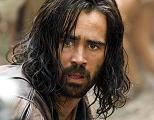 Just past the two-hour mark in Terrence Malick’s “The New World,” a character named Opechancanough–one of the “naturals,” as the film calls Native Americans–tells Rebecca, known as Pocahontas before her baptism, that he is being sent to England to “meet this God they talk about so much.”
Just past the two-hour mark in Terrence Malick’s “The New World,” a character named Opechancanough–one of the “naturals,” as the film calls Native Americans–tells Rebecca, known as Pocahontas before her baptism, that he is being sent to England to “meet this God they talk about so much.”
The irony of this statement is twofold: (1) There is very little actual dialogue in the first two hours of the movie, and (2) a small fraction of that dialogue is given over to talking about God. Which left me scratching my head over Opechancanough’s rather humorous comment.
At this point, I must disclose that I am not a real fan of Malick’s style. A philosophy student at both Harvard and Oxford, who later taught philosophy and translated Martin Heidegger’s works, Malick’s films are slower than expected, more sensitive to the voices within and without, and tend to dote on questions about nature and the place that humans make for themselves in it. Some find this liberating, others find it laborious. In this case, I felt like I was watching a Nature Channel special on the ecosystem of the Chesapeake Bay, blended with a continuous loop of Calvin Klein “Obsession” commercials–lots of shots of people strolling through tall grass, asking esoteric questions.
Using the star-crossed relationship of John Smith (Colin Farrell) and Pocahontas (Q’orianka Kilcher) to illuminate the conflicts between the “civilized” white settlers of Jamestown and the “natural” people whom they believed they found in a new Eden, the movie is typical Terrence Malick–deliberate pacing, some might say plodding, with an intense focus on the natural world.
Apart from that reference to Eden, which was made by Governer Christopher Newport (Christopher Plummer), along with a scene where Smith wonders aloud if he has gone against God’s wishes in loving Pochantas, the most obvious reference in “The New World” to the Christian God is the giant cross looming above the English fort, the same cross the “naturals” seemed to be trying to knock down earlier in the film. However, only a few times in the film do we get a glimpse at the role religion might have actually played in the Jamestown colony, such as when Captain Edward Wingfield (David Thewlis) strips Smith of his command based on a chapter from Leviticus and when Pocahontas is baptized and given the name Rebecca.
We see a bit more of the Native Americans’ spiritual lives–dances, sun salutations, prayer, and other rituals–but they are never explained in any detail. I understand that Malick intends for the audience to experience things just as Smith did, confused, scared, awed, and not clued in to what is happening, but it would have added to my experience and enjoyment of the movie if Malick had offered a few more clues to orient us.
And yet, a few days removed from seeing the film, I realize “The New World” is imbued with spiritul and religious notes that never quite took form for me while actually watching it. I can appreciate, if not completely agree with, Malick’s somewhat over-simplified sentiments about the purity and superiority of the Algonquin’s spiritual lives as compared to that of the English settlers; perhaps I was just expecting more spirituality and faith from a movie set in the 17th century, an era in which settlements came to be known “as plantations of religion.” Perhaps, though, it just takes a few days back in the real world to really appreciate “The New World.”


